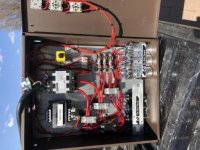Don Gitzel
Aluminum
- Joined
- Jul 25, 2017
So I just completed a 20 hp converter using a teco westinghouse TEXP 6 pole motor. I used mostly new parts save the start caps which I salvaged from a converter I had purchased for parts. On initial start one of the start caps blew like a Roman Candle bellowing black smoke. I immediately cut power. Upon further investigation I found the Capacitors were too low in value for the rated hp. I replaced the start Capacitors for 4 (400-480) caps. In my calculation 90 mfd per hp for starting equates to 20x90= 1800mfd. Before energizing I decided to add an additional Capacitor rated at 408-480 to the circuit in a temporary wiring mode. But I wired this cap wrong. It was wired not to disconnect from the circuit. When I energized a second time after 4 seconds there was a remarkable explosion and I ended up on my bum. I was working on the tailgate of my truck and the top of the capacitor that I added went about 30 ft in the air and landed on the hood of my truck. Well after insuring my nosy neighbor that I was good, I removed the temporary connection to the 5 th start Capacitor and energized the converter once more. All went well.




